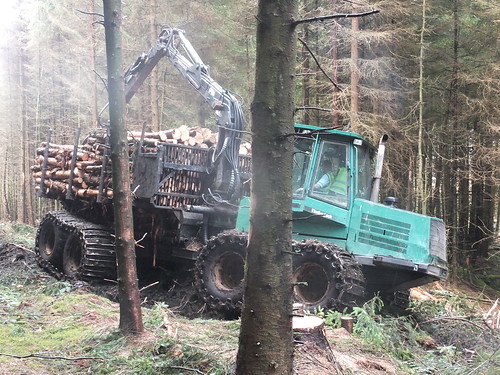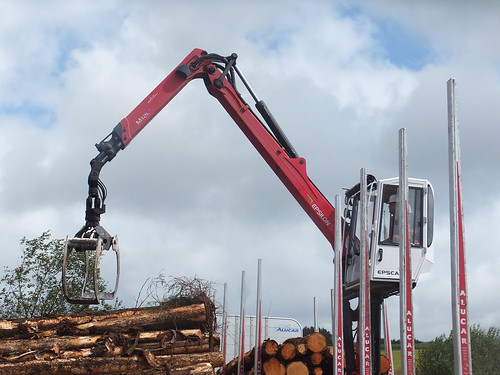 Harvester (left) awaiting hydraulic pipe; Forwarder (right) collecting logs already felled by the Harvester.
Harvester (left) awaiting hydraulic pipe; Forwarder (right) collecting logs already felled by the Harvester.
The Forwarder was a 'Timberjack' 1410D. According to the Wikipedia article here, Timberjack has been owned by John Deere since 2000. Although I knew John Deere for agricultural machines and mowers, I'd not realised their prominence in forestry. The John Deere Forestry website here claims that the company is "the worlds leading designer, manufacturer and distributor of forest machines". The 1410D Forwarder is no longer part of the current range but there's a detailed data sheet on this model here.
The Forwarder comprises two chassis sections or 'frames' each carried on a four-wheel patented balanced bogie. The 'frames' are joined by an articulated 'middle joint'. The design offers remarkable flexibility when working on uneven ground. The wheels are rubber-tyred but, where necessary, heavy chains can be fitted on each bogie, effectively producing a tracked vehicle.
 The 'Timberjack' 1410D Forwarder at work.
The 'Timberjack' 1410D Forwarder at work.
The area being felled at Ty Gwyn has parts which are soft and peaty, using the characteristics of the Forwarder to the full. Being situated on high ground in Wales, the Ty Gwyn woodland is generally wet, encouraging high growth rates but with the disadvantage that the trees tend to establish only shallow root systems, making them more prone to 'windblow' - uprooting by the wind.
 A tree brought down by 'windblow', showing the shallow 'rootplate'.
A tree brought down by 'windblow', showing the shallow 'rootplate'.
When I visited, the road haulier was using two 'rigs' to carry out the timber, both classed as "six wheel and drag". The 'six wheel' part has one steerable axle at the front and a double axle at the rear, based (I think) on a Scania truck chassis. This part has the cab, diesel engine, compartment for carrying logs and, at the rear, a crane for loading and unloading. The 'drag' is a three-axle trailer semi-permanently coupled to the front part with a further compartment for logs. To minimise the tare weight, the framework forming the load carrying compartments are made of aluminium by Alucar. The manufacturer's website is here. The crane I saw was a very smart 'Epsilon' Forest Crane. There are more details here. Once the driver is in the crane cab, it is raised hydraulically, giving the driver a better view of the loading and unloading process.
 With the crane cab in the raised position, the driver had a good view of the loading process.
With the crane cab in the raised position, the driver had a good view of the loading process.
It was recognised some years ago that lowering the pressure of pneumatic tyres increases the contact area between tyre and surface, improving handling on soft surfaces and reducing road damage. One of the two 'rigs' hauling from Ty Gwyn has a Central Tyre Inflation system ('CTI') enabling the driver to select the appropriate pressure for the work in hand from pushbuttons in the cab. Whilst I'd heard of the system, I hadn't realised the potential importance to the logging industry. You can read more:-
on Wikipedia,Some of the timber is being taken directly to Kronospan in Chirk either to make pallets or to be used in the making of wood panel products like MDF, (as described here), but the larger logs are being shipped to a different sawmill.
on How Stuff Works and
in a report on tests in 2006.
 Large logs (left) are being taken to a sawmill, smaller logs (right) go directly to Kronospan.
Large logs (left) are being taken to a sawmill, smaller logs (right) go directly to Kronospan.
Related articles on this site
Timber Extraction at Ty Gwyn.
All my Ty Gwyn posts.
The Manufacture of MDF (Describes a visit to Kronospan, Chirk).
My pictures
Harvesting (2) 2014 - this visit.
Harvesting (1) 2014 - previous visit.
All my Ty Gwyn pictures.
